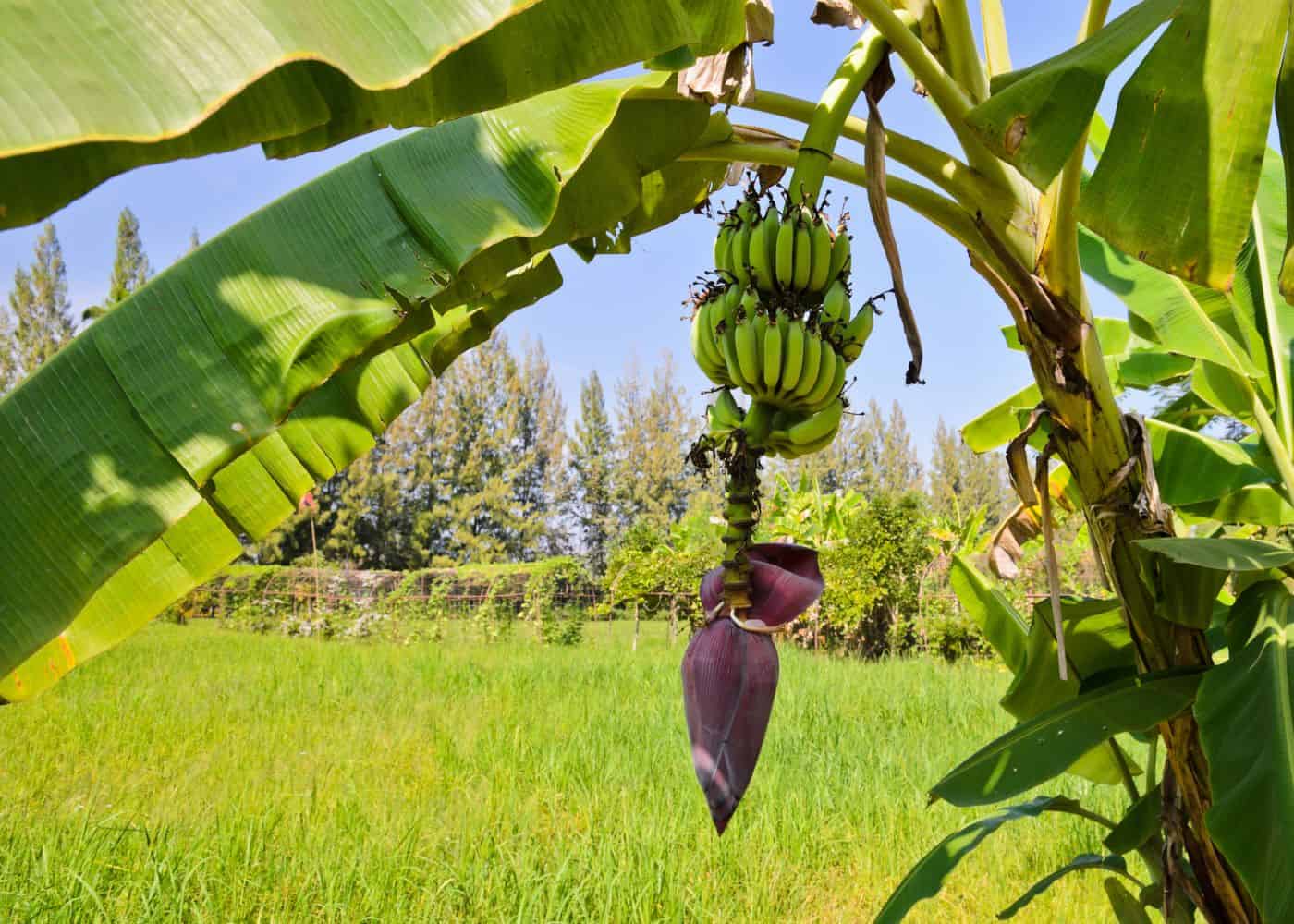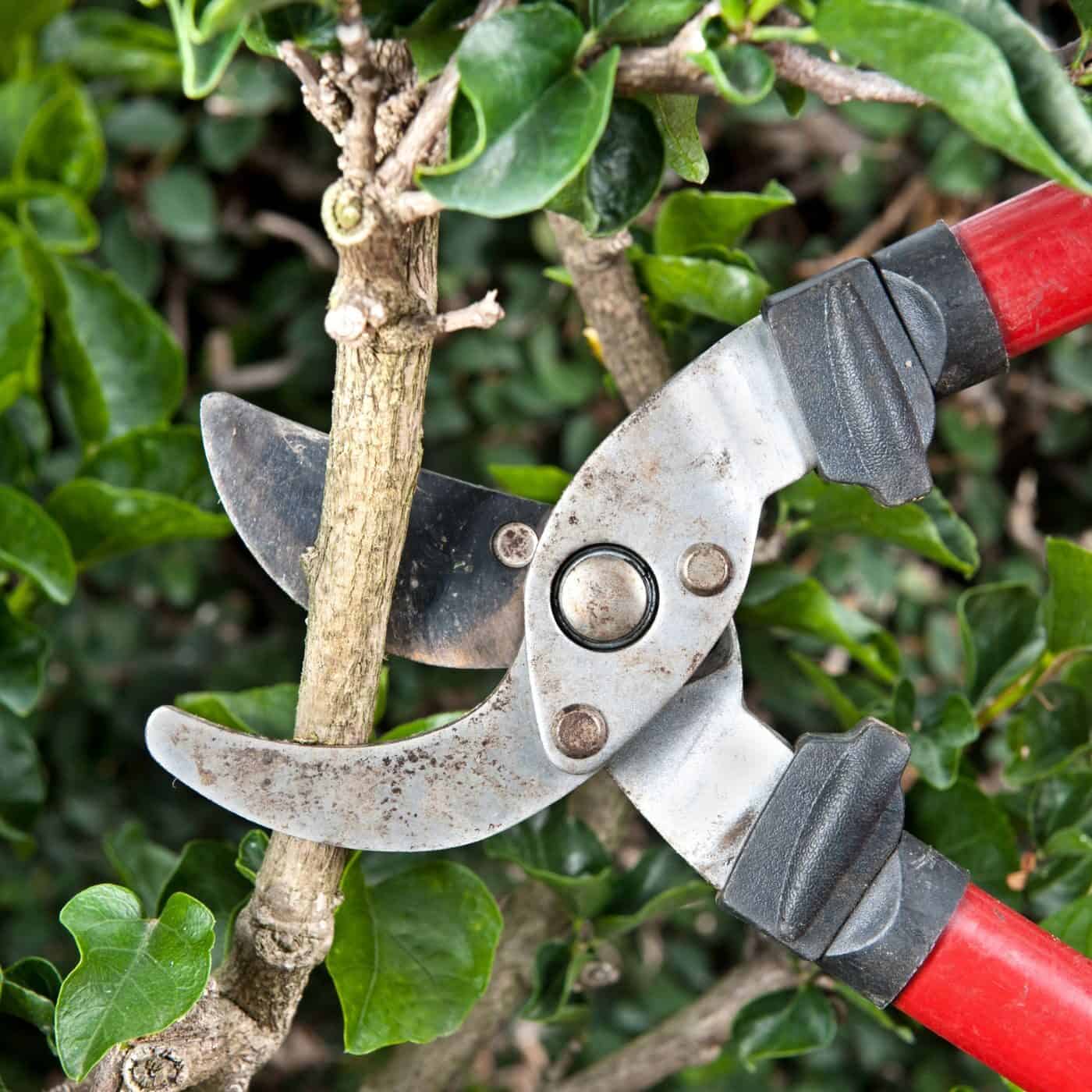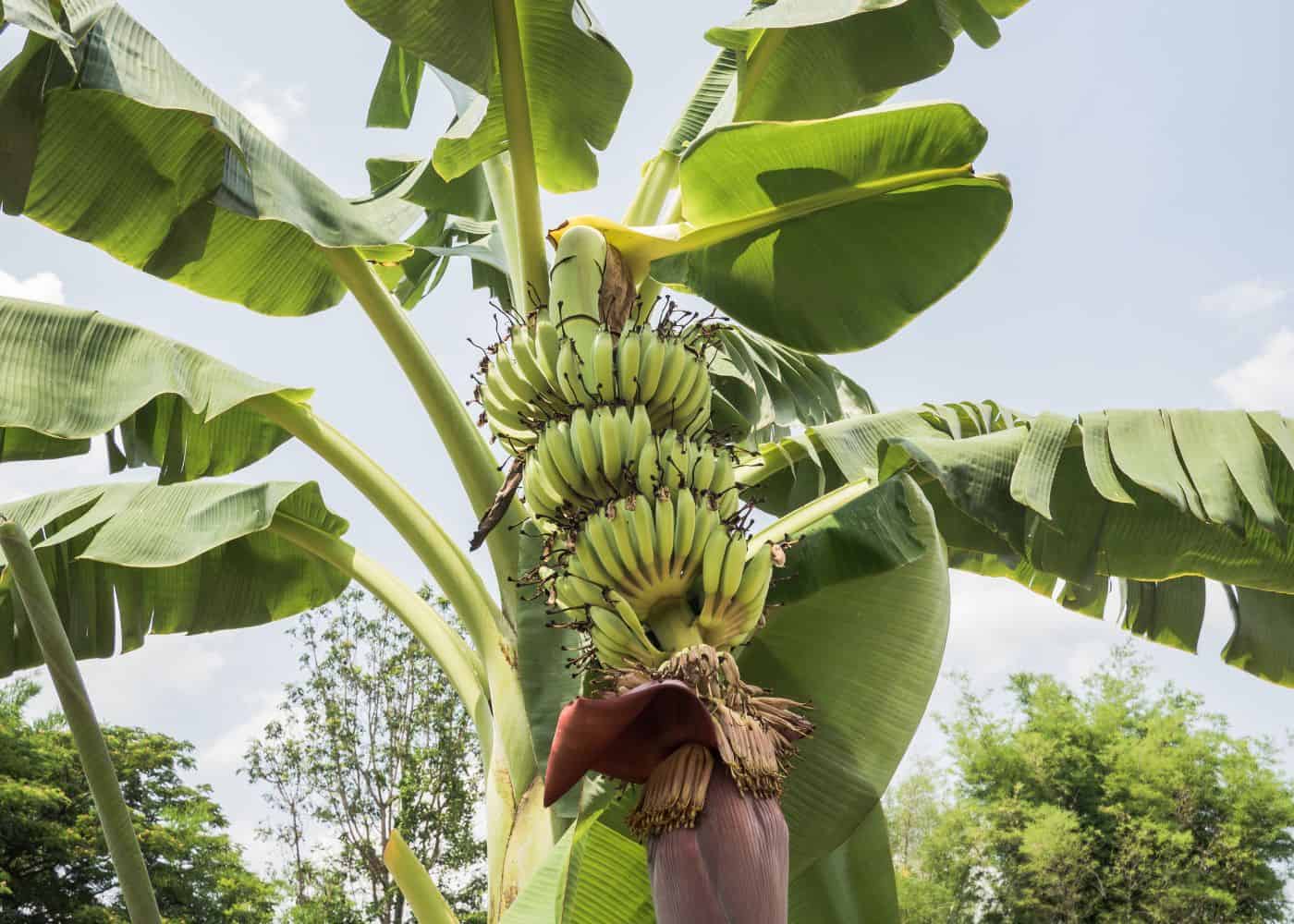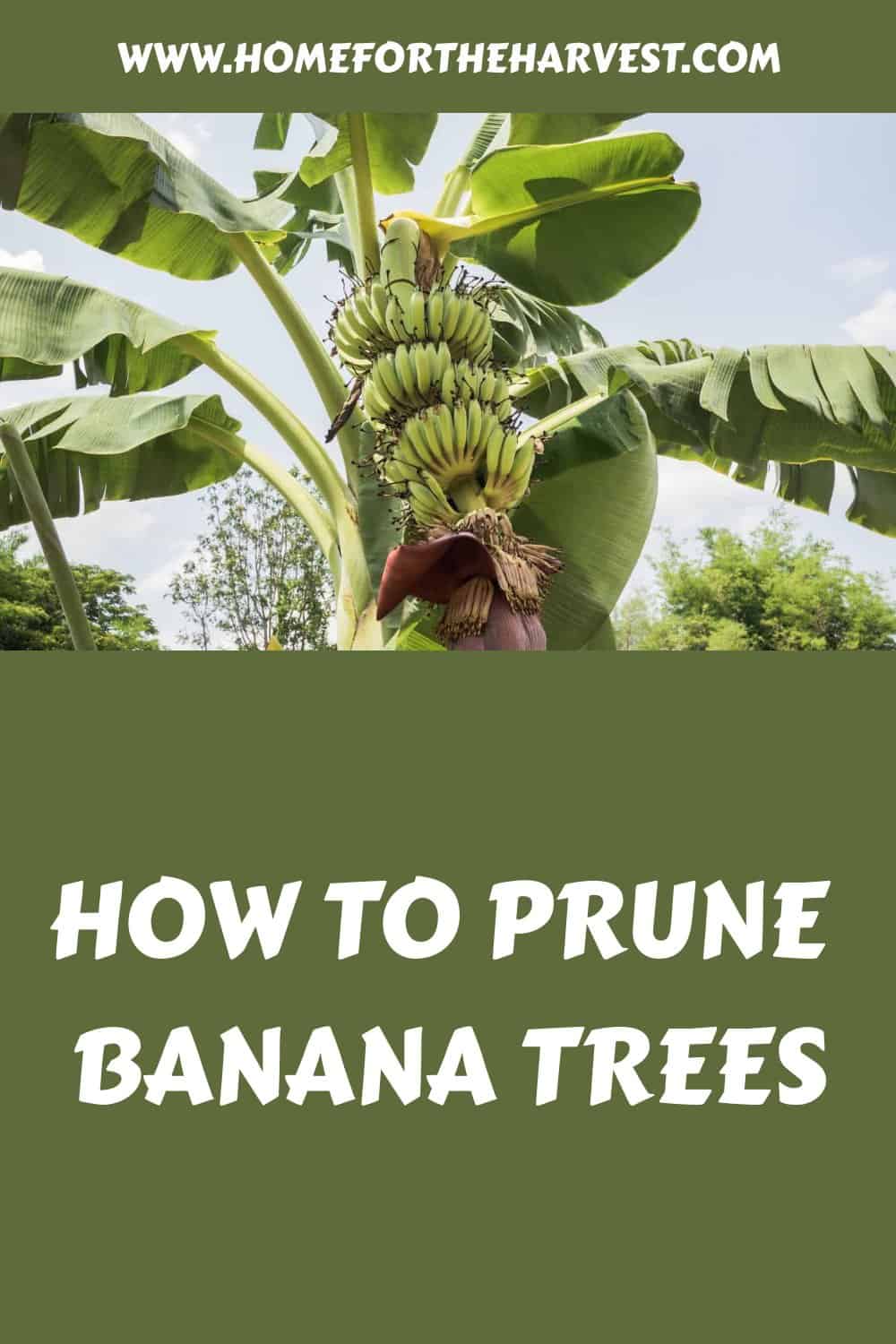If you want a strong banana harvest season after season, there are a few essential tasks to complete each year. One of those is pruning. Here is the guide for how to prune banana trees!
Pruning improves overall growth, prevents pests and diseases from attacking your plant and improves your yield for the following season. Light pruning to remove damaged leaves can be done throughout the year, with most of the plant cut back once the season is over to make way for new growth. Banana stalks can be tough, so sharp tools are vital to make clean cuts that heal quickly.
Why do banana trees need to be pruned?

Pruning is not always necessary for all garden plants. However, it does come with a long list of benefits that make the effort worthwhile. This is also the case for banana trees, where pruning is essential if you’re looking for high yields year after year.
Firstly, pruning is a vital defense against pest and disease damage. Although banana trees are not majorly prone to pest and disease issues, infestations can be quickly controlled with an effective pruning session. Pruning is also a great preventative measure, improving airflow around the leaves and removing any cozy areas where pests may like to settle in.
As counterproductive as it may seem, pruning is also a tool used to improve growth. Brown, yellowing and damaged leaves draw energy away from your banana tree that could be put toward new growth or better – more fruits. By cutting back damaged and unproductive areas, you make way for new, healthy growth to emerge.
Pruning also helps improve your harvest the following season. Banana trees only produce fruits on individual stalks once. Cutting back this stalk after fruiting conserves resources and allows the emerging sucker to grow bigger and stronger.
When is the best time to prune banana trees?
There are several times you may want to prune your banana tree, depending on the growth of the plant.
In the case of pests and diseases, it’s best to prune immediately to stop the problem from spreading. If you cannot control issues with the right treatments, cutting off affected plants will protect the rest of the leaves and stems, improving recovery time.
Damaged and dying leaves can also be trimmed whenever they pop up. These don’t have too much of a negative impact if left on the plant, but they will draw away energy that could be used to produce new fruits. Any debris on the plant or around the base also provides the ideal home for pests to settle in.
A big annual prune should be left until the end of the season once all the fruits have been harvested. Avoid cutting while the plant is still fruiting as this will impact growth and your potential harvest.
What will you need?

Even though the stems of banana trees are technically herbaceous, they are still incredibly tough plants. Younger trees can be pruned using shears or a very sharp knife, but larger and thicker areas will likely need to be cut with loppers or even a machete.
Make sure your tools are clean before you get started. Dirty tools can spread harmful bacteria and disease to your tree when it is most vulnerable.
How to prune banana trees?
Remove older leaves and brown leaves
To make removal easier, start with the outer leaves of the plant. These may be tough but are quicker to trim than the strong inner leaves and stems. Trim these off right down to the stem using your shears or loppers if they are tricky to remove. Work around the perimeter of the tree, continuing to trim back the brown outer leaves until you reach healthy growth in the middle.
Trim inner leaves
When you’re pruning early in the season, you can typically leave the inner leaves alone. However, if any are damaged or show signs of pest and disease damage, it’s better to cut those off than leave them on the plant.
For the end-of-season cutback, you can remove more of the leaves. In colder regions where frost will kill off the leaves, you can remove all the leaves. However, in warmer tropical areas without frost, you can keep these leaves for their aesthetic value until you are ready to cut the main stalk back.
During fruiting, make sure you don’t damage any parts of the stem while cutting the leaves back, even if they are difficult to remove. Any damage to the stem will impact the plant’s ability to produce fruit and makes the tree more vulnerable to disease.
Identify the strongest sucker and remove the rest
Next, take a look at the base of your plant to identify suckers. These are smaller versions of the plant that emerge from the soil as the plant spreads, ready to grow into fuller stems.
Suckers draw energy away from the plant that could go to fruiting, so you don’t want to keep all of them. Identify the sucker with the strongest growth and cut the rest of them back. This will become the main fruiting stalk next season.
Cut back the main stalk
Finally, once you’re ready to end your banana growing season, cut the main stalk down to the ground, leaving the sucker growing next to it. This stalk will use up resources the next season without producing any fruits if it is not cut.
You can chop up the stalk and sprinkle it around the base of the plant to feed the soil, or throw it on your compost pile.
Before you go….
Do you want to learn more about how to grow the best banana trees? Click here to learn more!
FAQs about pruning banana trees
How far back should I cut my banana tree?
It depends on the reason for pruning the banana tree. If the tree is overgrown, you can cut it back to within a few feet of the ground to promote new growth. If the tree is diseased or damaged, it may be necessary to cut it back to healthy wood. It’s always best to consult a professional or do some research on the specific variety of banana tree you have to make sure you are properly caring for it.
Should I cut the dead leaves off my banana tree?
Yes, it is a good idea to remove dead leaves from your banana tree. Dead leaves can harbor pests and diseases and can also interfere with the tree’s ability to photosynthesize and produce new growth. It is best to remove the leaves as close to the base of the leaf stem as possible to avoid damaging the tree. Also removing the dried leaves will help the tree to focus its energy on producing new leaves and fruit instead of maintaining the dead leaves. It’s also important to regularly inspect your banana tree for any signs of pests or disease, as early detection and treatment can help prevent serious problems.
Can you cut the top off a banana tree?
Yes, it is possible to cut the top off a banana tree, also called “topping” . This is a method of pruning that involves removing the top of the tree, usually to control its height or shape. However, topping a banana tree is not recommended as a regular practice because it can cause the tree to produce fewer fruit, and can also make the tree more susceptible to pests and diseases. Banana trees are typically propagated from the underground stem, called corm. Cutting the top of the tree may also damage the corm and affect the tree’s ability to produce new growth. Instead, it is generally recommended to remove any dead or damaged leaves, and to selectively prune away any suckers (new shoots) that are growing from the base of the tree. This will help the tree to focus its energy on producing fruit and new growth, while maintaining a healthy shape.
How do you winterize banana plants?
Winterizing banana plants involves taking steps to protect the plants from cold temperatures and frost, as most banana varieties are not cold-hardy and can be damaged or killed by freezing temperatures. Here are a few ways to winterize banana plants:
Move container plants indoors: If you have banana plants in pots, bring them indoors or into an unheated greenhouse where temperatures will stay above freezing.
Mulch the banana tree: Mulch can help to insulate the roots of the banana tree and keep them from freezing. Use a thick layer of straw, leaves, or wood chips.
Cover the banana plant: Covering the banana plant with a frost blanket or burlap can provide extra insulation and protect it from freezing temperatures.
Provide heat: If you are unable to move the banana plant indoors, you can use a heat lamp or Christmas lights to provide some extra warmth.
Keep the soil moist: In winter, banana plants need to be watered less frequently than in summer but the soil should not be allowed to dry out completely.
It is also important to note that not all banana varieties are winter hardy, so some varieties may not survive the winter even with proper care. Some varieties like the Musa Basjoo, which is hardy to -20F are more suitable for colder regions. It is important to research the variety of banana plant you have to know if it’s suitable for your climate
References
Banana trees
Want to learn more about the do’s and don’ts of bananas? Learn more by clicking below!







